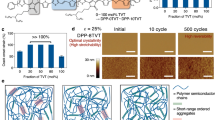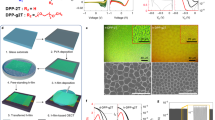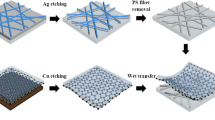Abstract
Despite recent progress in producing transparent and bendable thin-film transistors using graphene and carbon nanotubes1,2, the development of stretchable devices remains limited either by fragile inorganic oxides or polymer dielectrics with high leakage current3,4. Here we report the fabrication of highly stretchable and transparent field-effect transistors combining graphene/single-walled carbon nanotube (SWCNT) electrodes and a SWCNT-network channel with a geometrically wrinkled inorganic dielectric layer. The wrinkled Al2O3 layer contained effective built-in air gaps with a small gate leakage current of 10−13 A. The resulting devices exhibited an excellent on/off ratio of ~105, a high mobility of ~40 cm2 V−1 s−1 and a low operating voltage of less than 1 V. Importantly, because of the wrinkled dielectric layer, the transistors retained performance under strains as high as 20% without appreciable leakage current increases or physical degradation. No significant performance loss was observed after stretching and releasing the devices for over 1,000 times. The sustainability and performance advances demonstrated here are promising for the adoption of stretchable electronics in a wide variety of future applications.
This is a preview of subscription content, access via your institution
Access options
Subscribe to this journal
Receive 12 print issues and online access
$259.00 per year
only $21.58 per issue
Buy this article
- Purchase on Springer Link
- Instant access to full article PDF
Prices may be subject to local taxes which are calculated during checkout





Similar content being viewed by others
Change history
08 March 2013
In the version of this Letter originally published online, in the left panel in Fig. 3a, the schematic of the device was missing. This error has been corrected in all versions of the Letter.
References
Cao, Q. et al. Highly bendable, transparent thin-film transistors that use carbon-nanotube-based conductors and semiconductors with elastomeric dielectrics. Adv. Mater. 18, 304–309 (2006).
Yu, W. J. et al. Small hysteresis nanocarbon-based integrated circuits on flexible and transparent plastic substrate. Nano Lett. 11, 1344–1350 (2011).
Moghal, J., Suttle, H., Cook, A. G., Grovenor, C. R. M. & Assender, H. Investigation of the mechanical properties of aluminium oxide thin films on polymer substrates by a combination of fragmentation and scratch testing. Surf. Coat. Technol. 206, 3309–3315 (2012).
Schroeder, R., Majewski, L. A. & Grell, M. High-performance organic transistors using solution-processed nanoparticle-filled high-k polymer gate insulators. Adv. Mater. 17, 1535–1539 (2007).
Avouris, P., Chen, Z. H. & Perebeinos, V. Carbon-based electronics. Nature Nanotech. 2, 605–615 (2007).
Cao, Q. et al. Medium-scale carbon nanotube thin-film integrated circuits on flexible plastic substrates. Nature 454, 495–500 (2008).
Sun, D. et al. Flexible high-performance carbon nanotube integrated circuits. Nature Nanotech. 6, 156–161 (2011).
Wang, C. et al. Extremely bendable, high-performance integrated circuits using semiconducting carbon nanotube networks for digital, analog, and radio-frequency applications. Nano Lett. 12, 1527–1533 (2012).
Kim, S. K., Kim, S. M., Park, J. S., Ju, S. H. & Mohammadi, S. Fully transparent pixel circuits driven by random network carbon nanotube transistor circuitry. ACS Nano 4, 2994–2998 (2010).
Kim, K. S. et al. Large-scale pattern growth of graphene films for stretchable transparent electrodes. Nature Mater. 457, 706–710 (2009).
Li, X. et al. Transfer of large-area graphene films for high-performance transparent conductive electrodes. Nano Lett. 9, 4359–4363 (2009).
Bae, S. et al. Roll-to-roll production of 30-inch graphene films for transparent electrodes. Nature Nanotech. 5, 574–578 (2010).
Roberts, M. E. et al. Cross-linked polymer gate dielectric film for low-voltage organic transistor. Chem. Mater. 21, 2292–2299 (2009).
Xuyen, N. T. et al. Enhancement of conductivity by diameter control of polyimide-based electrospun carbon nanofibers. J. Phys. Chem. B 111, 11350–11353 (2007).
Han, G. H. et al. Influence of copper morphology in forming nucleation seeds for graphene growth. Nano Lett. 11, 4144–4148 (2011).
Khang, D. Y., Jiang, H., Huang, Y. & Rogers, J. A. A stretchable form of single-crystal silicon for high-performance electronics on rubber substrates. Science 311, 208–212 (2006).
Sun, Y., Kumar, V., Adesida, I. & Rogers, J. A. Buckled and wavy ribbons of GaAs for high-performance electronics on elastomeric substrates. Adv. Mater. 18, 2857–2862 (2006).
Xiao, J. et al. Stretchable and compressible thin films of stiff materials on compliant wavy substrates. Appl. Phys. Lett. 93, 013109 (2008).
Keong, J., Kim, S., Cho, J. & Hong, Y. Stable stretchable silver electrode directly deposited on wavy elastomeric substrate. IEEE Electron Device Lett. 30, 1284–1286 (2007).
Jeong, S. Y. et al. Efficient synthesis of individual single-walled carbon nanotube by water-based catalyst with poly(vinylpyrrolidone). J. Nanosci. Nanotechnol. 8, 329–334 (2008).
Liao, L. et al. Top-gated graphene nanoribbon transistors with ultra-thin high- k dielectrics. Proc. Natl Acad. Sci. USA 10, 1917–1921 (2010).
Neamen, D. A. Semiconductor Physics and Devices: Fundamentals of the Metal-Oxide-Semiconductor Field-effect Transistor Ch. 12 (Homewood, 1992).
Kang, S. J. et al. High-performance electronics using dense, perfectly aligned arrays of single-walled carbon nanotubes. Nature Nanotech. 2, 230–236 (2007).
Cao, Q. et al. Gate capacitance coupling of singled-walled carbon nanotube thin-film transistors. Appl. Phys. Lett. 90, 023516 (2007).
Franklin, A. D. et al. Sub-10 nm carbon nanotube transistor. Nano Lett. 12, 758–762 (2012).
Li, Q. et al. Structure-dependent electrical properties of carbon nanotube fibers. Adv. Mater. 19, 3358–3363 (2007).
Zhang, Y. et al. Polymer-embedded carbon nanotube ribbons for stretchable conductors. Adv. Mater. 22, 3027–3031 (2010).
Hu, L., Yuan, W., Brochu, P., Gruner, G. & Pei, Q. Highly stretchable, conductive, and transparent nanotube thin films. Appl. Phys. Lett. 94, 161108 (2009).
Yu, C., Masarapu, C., Rong, J., Wei, B. & Jiang, H. Stretchable supercapacitors based on buckled single-walled carbon nanotube macrofilms. Adv. Mater. 21, 4793–4797 (2009).
Shackelford, J. F. & Alexander, W. Materials Science and Engineering Handbook (CRC, 2001).
Acknowledgements
This work was supported by the Research Centre Program of IBS (Institute for Basic Science) in Korea, the International Research & Development Program (2011-00242) of the NRF of Korea funded by MEST, and the Human Resources Development programme (No. 20124010203270) of the KETEP funded by the Korea government Ministry of Knowledge Economy.
Author information
Authors and Affiliations
Contributions
S.H.C. contributed to the experimental planning, experimental measurements, data analysis and manuscript preparation. W.J.Y. and X.D. performed the experimental planning. D.L.D. performed the AFM measurement, J.J.B. and Q.A.V. performed the finite-element method simulation, and H.Y.J. took the photographic images. D.P. and M.J.Y. contributed to the theoretical calculations. Q.H.T. and T.H.L. prepared the graphene samples for the experiments. Y.H.L. contributed to the experimental planning, data analysis and manuscript preparation.
Corresponding author
Ethics declarations
Competing interests
The authors declare no competing financial interests.
Supplementary information
Supplementary Information
Supplementary Information (PDF 3195 kb)
Rights and permissions
About this article
Cite this article
Chae, S., Yu, W., Bae, J. et al. Transferred wrinkled Al2O3 for highly stretchable and transparent graphene–carbon nanotube transistors. Nature Mater 12, 403–409 (2013). https://doi.org/10.1038/nmat3572
Received:
Accepted:
Published:
Issue Date:
DOI: https://doi.org/10.1038/nmat3572
This article is cited by
-
Pseudo-break imaging of carbon nanotubes for determining elastic bending energies
Nano Research (2023)
-
Carbon nanotube-graphene hybrids for soft electronics, sensors, and actuators
Micro and Nano Systems Letters (2022)
-
Stretchable transistors and functional circuits for human-integrated electronics
Nature Electronics (2021)
-
Synthesis and characterization of graphene/carbon nanotube hybrid: effects of Ni catalyst thickness and H2 flow rate on growth and morphological structure
Journal of Materials Science: Materials in Electronics (2021)
-
Computational study of the water-driven graphene wrinkle life-cycle towards applications in flexible electronics
Scientific Reports (2020)



